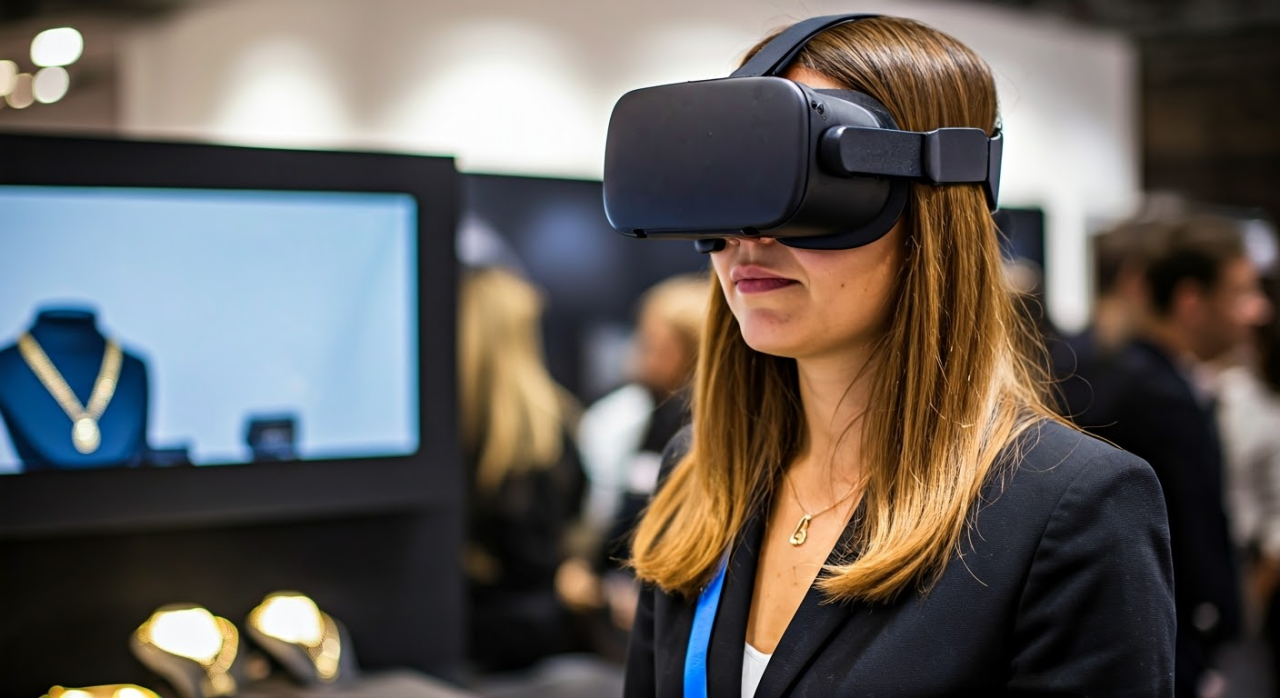5 Benefits of using VR Virtual Tours at International B2B Jewellery Tradeshows
Prelude: Video of my webinar on “VR Virtual tours at jewellery tradeshows: What? Why? How?”: https://youtu.be/TJ3figZz_tU
B2B international jewelry tradeshows are vital events where industry professionals gather to display their latest creations, forge business relationships, and secure orders. In a highly competitive environment, exhibitors need innovative methods to attract and retain the attention of potential buyers. Virtual Reality (VR) virtual tours offer a revolutionary approach to enhance the tradeshow experience. Here are five compelling benefits of using VR virtual tours at your next B2B international jewelry tradeshows:
1. Enhanced Visualization and Immersion
Jewelry showcasing requires a high level of detail and sophistication to highlight the beauty and craftsmanship of each piece. VR virtual tours provide an unparalleled platform for this.
Detailed Examination:
With VR, potential buyers can explore jewelry pieces in high resolution, allowing them to appreciate intricate details and craftsmanship from various angles. This level of examination surpasses what is possible through traditional displays and even high-quality photographs.
Immersive Environments:
VR tours can place buyers in a variety of immersive settings that enhance the appeal of the jewelry. For instance, buyers can experience a luxurious boutique or a glamorous fashion show setting, making the jewelry appear even more desirable. These immersive environments create memorable experiences that can positively influence buying decisions.
2. Interactive and Personalized Experiences
Engagement and personalization are crucial in capturing the interest of buyers at tradeshows. VR virtual tours offer a dynamic and interactive way to showcase jewelry.
Interactive Exploration:
Buyers can navigate through virtual showrooms at their own pace, interacting with the jewelry in a way that suits their interests. They can pick up, rotate, and zoom in on pieces, providing a level of interactivity that physical displays cannot match.
Personalized Tours:
VR technology allows for personalized tours based on the buyer’s preferences. Exhibitors can tailor the virtual tour experience to highlight collections or pieces that are most relevant to the buyer’s interests, enhancing the relevance and impact of the showcase.
3. Cost-Effective and Efficient Showcasing
Transporting and securely displaying valuable jewelry at international tradeshows can be expensive and logistically challenging. VR virtual tours offer a cost-effective and efficient alternative.
Reduced Transportation and Security Costs:
By using VR to showcase jewelry collections, exhibitors can minimize the need to transport physical pieces. This not only reduces transportation costs but also lowers the risk of loss or theft, reducing the need for extensive security measures.
Efficient Space Utilization:
VR virtual tours allow exhibitors to present extensive collections without the need for large physical spaces. Buyers can explore numerous pieces in a virtual environment, making the most of the available booth space and ensuring a more organized and efficient display.
4. Accessibility and Convenience
VR virtual tours make it easier for potential buyers to access and explore jewelry collections, both during and after the tradeshow.
Remote Access:
Buyers who cannot attend the tradeshow in person can still experience the virtual tour from anywhere in the world. This extends the reach of the tradeshow and allows exhibitors to engage with a global audience without the limitations of physical presence.
Extended Engagement:
VR tours can be available beyond the duration of the tradeshow, allowing buyers to revisit the virtual showroom at their convenience. This extended access can lead to more thoughtful decision-making and increased opportunities for follow-up interactions and sales.
5. Data Collection and Analytical Insights
Understanding buyer behavior and preferences is crucial for optimizing your tradeshow strategy. VR virtual tours provide advanced data collection and analytics capabilities that offer valuable insights.
Behavioral Analytics:
VR systems can track how buyers interact with the virtual tour, including which pieces they spend the most time viewing and what aspects they engage with the most. This data helps exhibitors understand buyer preferences and tailor their offerings accordingly.
Feedback Mechanisms:
VR tours can include built-in feedback tools, such as surveys or interactive polls, allowing exhibitors to collect real-time feedback from buyers. This feedback provides insights into what buyers liked or disliked about the VR experience and the jewelry pieces, helping exhibitors refine their strategies for future events.
Informed Decision Making:
By analyzing the data collected through VR interactions, exhibitors can make informed decisions about their product lines, marketing strategies, and tradeshow presentations. This data-driven approach can lead to more effective and targeted efforts, ultimately boosting sales and enhancing buyer satisfaction.
Conclusion
Incorporating VR virtual tours into B2B international jewelry tradeshows offers numerous benefits, from enhanced visualization and interactive experiences to cost-effective showcasing and valuable data insights. By leveraging VR technology, exhibitors can create a memorable and engaging experience for buyers, effectively communicate the value and uniqueness of their jewelry pieces, and gain a competitive edge in a crowded marketplace. As VR technology continues to advance, its applications in the jewelry industry will only grow, making it a valuable tool for businesses looking to innovate and excel in their tradeshow efforts.




